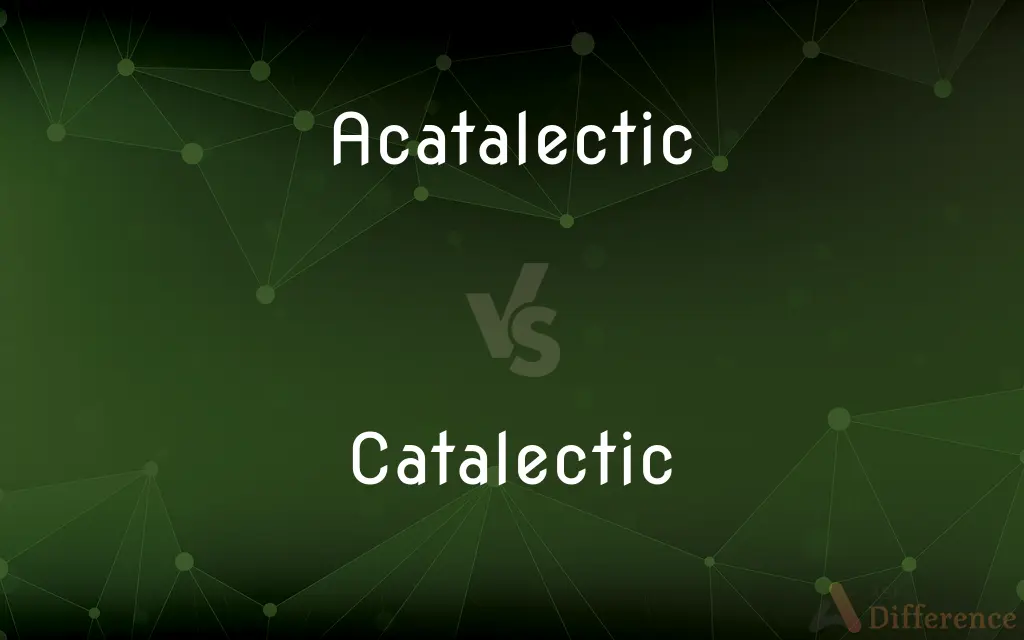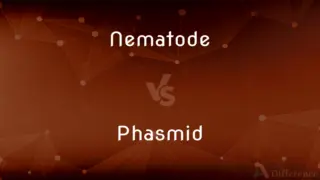Acatalectic vs. Catalectic — What's the Difference?
By Maham Liaqat & Fiza Rafique — Updated on April 8, 2024
Acatalectic meter is complete, with the expected number of syllables, while catalectic meter lacks one or more syllables.

Difference Between Acatalectic and Catalectic
Table of Contents
ADVERTISEMENT
Key Differences
Acatalectic refers to a line of verse that has the complete number of syllables, typically as expected in a metric pattern. This completeness allows the verse to maintain a rhythmic consistency, essential in poetry and music. On the other hand, catalectic refers to a metric line that is shortened by one or more syllables, disrupting the standard metric pattern. This can add variety, emphasis, or a particular rhythmic effect to the verse.
While acatalectic lines provide a sense of completeness and balance, catalectic lines introduce a deliberate irregularity. This irregularity can be used to draw attention to specific parts of the verse or to create a certain mood. Whereas acatalectic lines adhere strictly to the expected metric form, catalectic lines break away from this form, offering flexibility and a break from the predictability of the rhythm.
In terms of literary effect, acatalectic lines can convey a feeling of stability and predictability, which might be desired in certain contexts. Conversely, catalectic lines can evoke a sense of unexpectedness or tension, useful in creating dramatic or emotional effects in poetry.
Poets and composers choose acatalectic or catalectic lines based on the effect they wish to achieve in their work. While acatalectic verses align with traditional metric patterns, providing a smooth and consistent flow, catalectic verses allow for creative departures from these patterns, introducing variability and interest.
The choice between acatalectic and catalectic forms depends on the thematic and emotional goals of the piece. Acatalectic lines might be chosen for works aiming for harmony and completeness, whereas catalectic lines could be preferred for pieces that seek to challenge, question, or highlight certain elements through rhythmic variation.
ADVERTISEMENT
Comparison Chart
Syllable Count
Complete number of syllables
Missing one or more syllables
Metric Consistency
Maintains consistent metric pattern
Breaks from standard metric pattern
Literary Effect
Conveys stability and predictability
Evokes unexpectedness or tension
Use in Verse
Provides a smooth and consistent flow
Introduces variability and interest
Thematic Implication
Suitable for themes of harmony and balance
Preferred for themes of disruption or emphasis
Compare with Definitions
Acatalectic
A verse with a complete set of syllables.
The sun also rises, bringing warmth and light.
Catalectic
Lines with syllable reduction for effect.
Listen! the wind is rising, and the air is wild with leaves.
Acatalectic
Lines without syllable omission, maintaining rhythm.
Her laughter was a question he wanted to spend his whole life answering.
Catalectic
Poetry that deviates from the full metric pattern.
Of the beautiful Annabel Lee. And the stars never rise but I feel the bright eyes.
Acatalectic
Standard metric lines in verse composition.
The curfew tolls the knell of parting day.
Catalectic
Verses that create rhythmic variation.
He holds him with his glittering eye—The Wedding-Guest stood still.
Acatalectic
Poetry that adheres to the expected metric structure.
Upon the midnight dreary, while I pondered, weak and weary.
Catalectic
A verse lacking one or more syllables.
For the moon never beams without bringing me dreams.
Acatalectic
Full verses in poetry or songs.
The road not taken has made all the difference.
Catalectic
Incomplete verses in poetic works.
We loved with a love that was more than love.
Acatalectic
Having a metrically complete pattern, especially having the full number of syllables in the final foot. Used of verse.
Catalectic
A catalectic line is a metrically incomplete line of verse, lacking a syllable at the end or ending with an incomplete foot. One form of catalexis is headlessness, where the unstressed syllable is dropped from the beginning of the line.
Acatalectic
Designating a line of verse having the required number of syllables in the last foot
Catalectic
Lacking one or more syllables, especially in the final foot. Used of verse.
Acatalectic
A verse which has the complete number of feet and syllables
Catalectic
(poetry) said of a line with incomplete meter lacking a syllable at the end or ending with an incomplete foot.
Acatalectic
Not defective; complete; as, an acatalectic verse.
Catalectic
Incomplete; partial; not affecting the whole of a substance
Acatalectic
(verse) having an extra syllable or syllables at the end of a metrically complete verse or in a metrical foot
Catalectic
(poetry) A line with incomplete meter, lacking a syllable at the end or ending with an incomplete foot.
Catalectic
Wanting a syllable at the end, or terminating in an imperfect foot; as, a catalectic verse.
Catalectic
Incomplete; partial; not affecting the whole of a substance.
Catalectic
(verse) having an extra syllable or syllables at the end of a metrically complete verse or in a metrical foot
Common Curiosities
What does catalectic mean in poetry?
Catalectic in poetry refers to a line that is shortened by missing one or more syllables, altering the standard metric pattern.
Can a poem be both acatalectic and catalectic?
Yes, a poem can have both acatalectic and catalectic lines, creating a variety of rhythmic effects.
What is an acatalectic line?
An acatalectic line is a line of verse that contains the complete number of syllables expected in its metric pattern.
How does acatalectic differ from catalectic in terms of rhythm?
Acatalectic maintains a consistent rhythm by adhering to the expected syllable count, whereas catalectic disrupts this rhythm by omitting syllables.
Why would a poet choose a catalectic line?
A poet might choose a catalectic line to introduce emphasis, create a particular mood, or draw attention to certain words or themes.
What is a simple example of an acatalectic line?
"The woods are lovely, dark, and deep," is an example of an acatalectic line with a complete syllable count.
Are acatalectic lines more common than catalectic lines?
The prevalence of acatalectic versus catalectic lines depends on the poet's style, the poem's form, and the desired effect.
Can catalectic lines be found in music?
Yes, catalectic lines can be found in the lyrics of songs, where syllable omission may contribute to the melody or rhythm.
Is catalexis only applicable to poetry?
While most commonly used in poetry, the concept of catalexis can apply to any rhythmic or lyrical composition, including music.
How does a catalectic ending affect a verse?
A catalectic ending can lend a sense of abruptness or emphasis to the closing lines of a verse, impacting its overall tone.
How does catalectic affect the mood of a poem?
Catalectic can affect the mood by introducing tension, surprise, or a feeling of incompleteness, enhancing the poem's emotional impact.
What role does acatalectic play in classical poetry?
In classical poetry, acatalectic lines adhere to strict metrical patterns, contributing to the harmony and structure of the verse.
What is the significance of syllable count in acatalectic and catalectic lines?
The syllable count in acatalectic and catalectic lines determines the rhythm and flow of the verse, playing a crucial role in its structure and effect.
Can modern poetry employ acatalectic and catalectic lines?
Modern poetry often employs both acatalectic and catalectic lines, utilizing them for diverse stylistic and thematic purposes.
How do acatalectic and catalectic lines influence reader interpretation?
The presence of acatalectic or catalectic lines can influence a reader's interpretation by affecting the rhythm, emphasis, and mood of the poem.
Share Your Discovery

Previous Comparison
Rank vs. Level
Next Comparison
Nematode vs. PhasmidAuthor Spotlight
Written by
Maham LiaqatCo-written by
Fiza RafiqueFiza Rafique is a skilled content writer at AskDifference.com, where she meticulously refines and enhances written pieces. Drawing from her vast editorial expertise, Fiza ensures clarity, accuracy, and precision in every article. Passionate about language, she continually seeks to elevate the quality of content for readers worldwide.















































